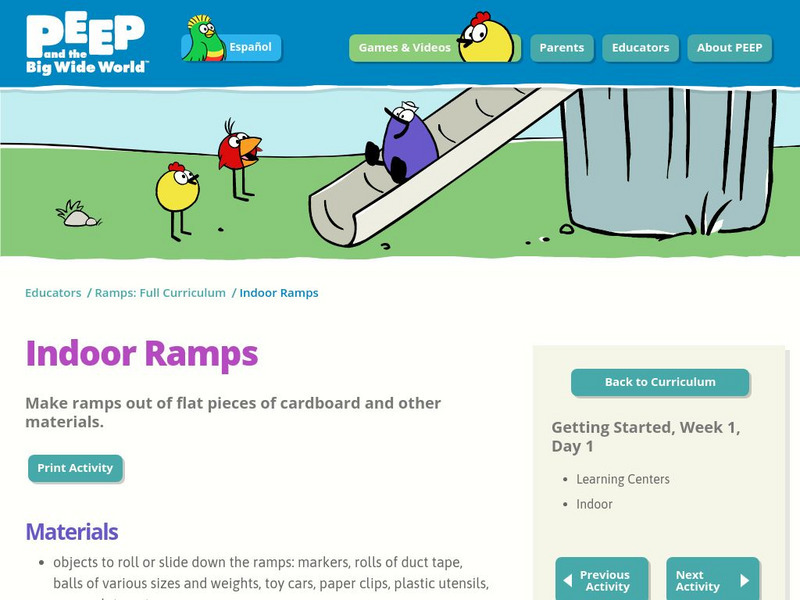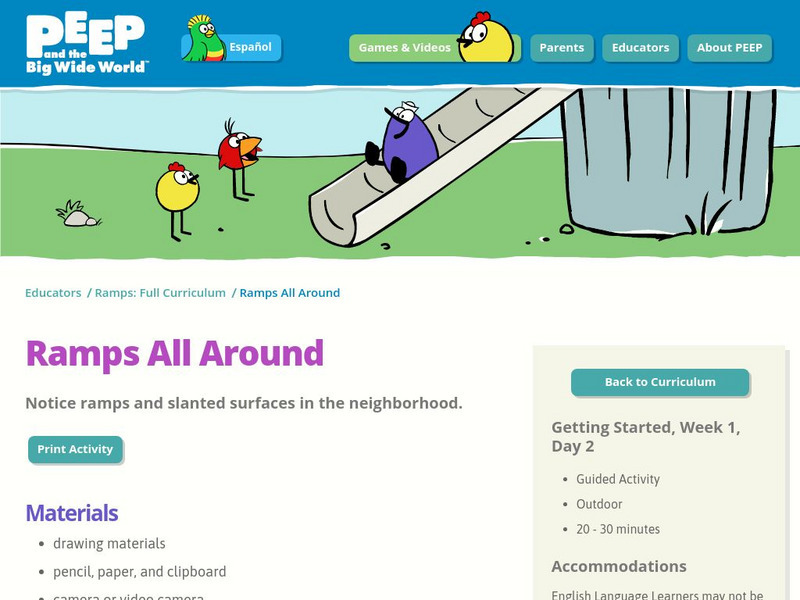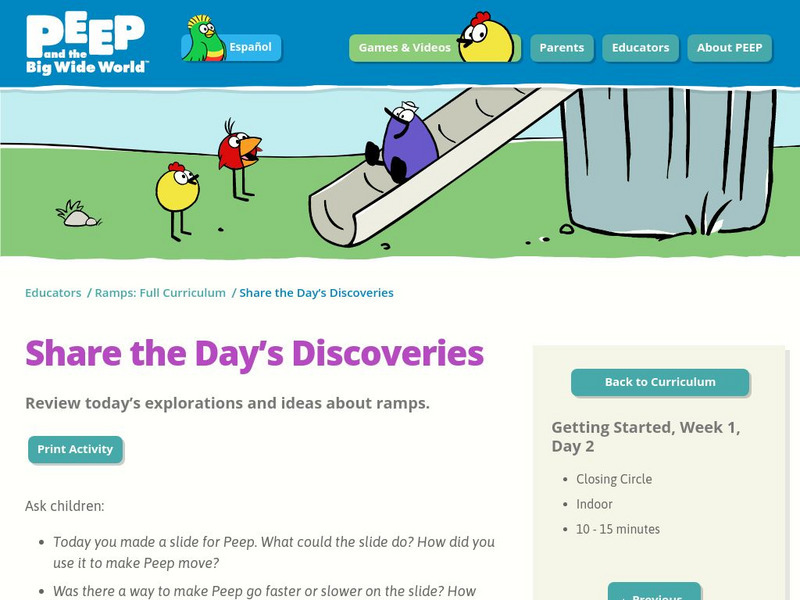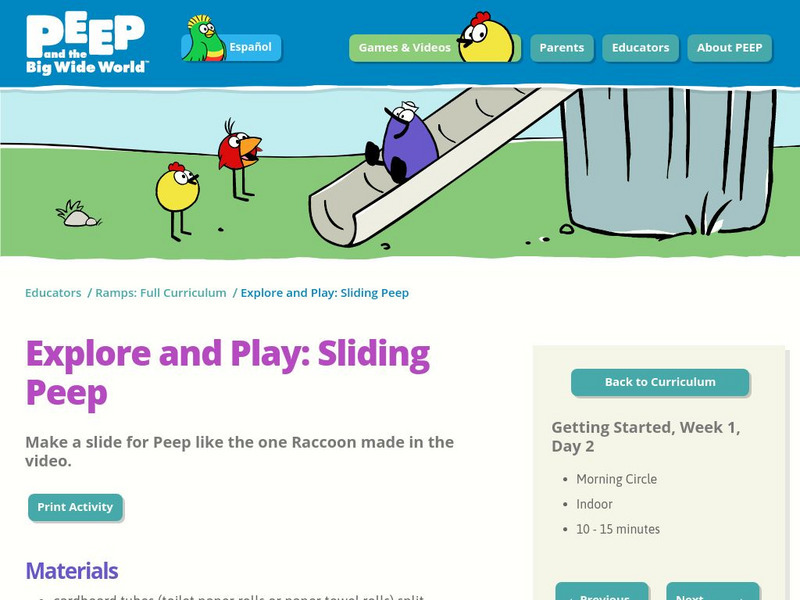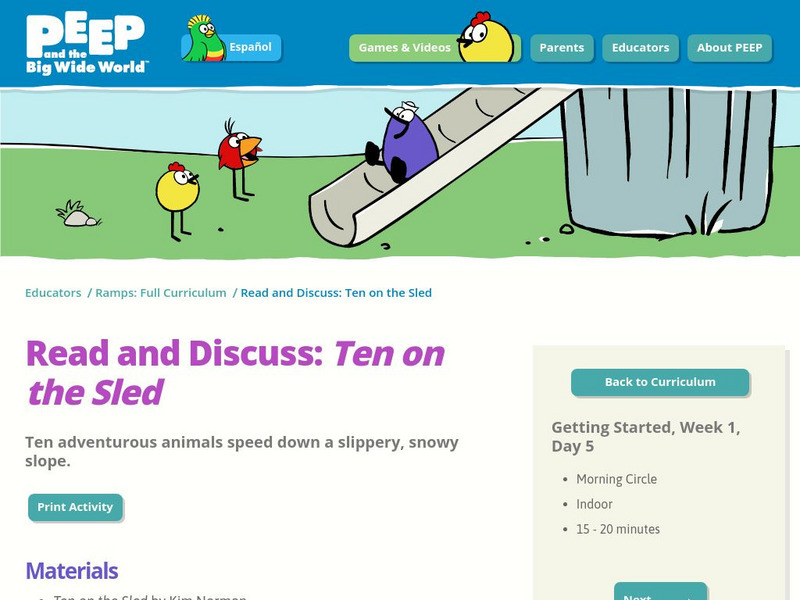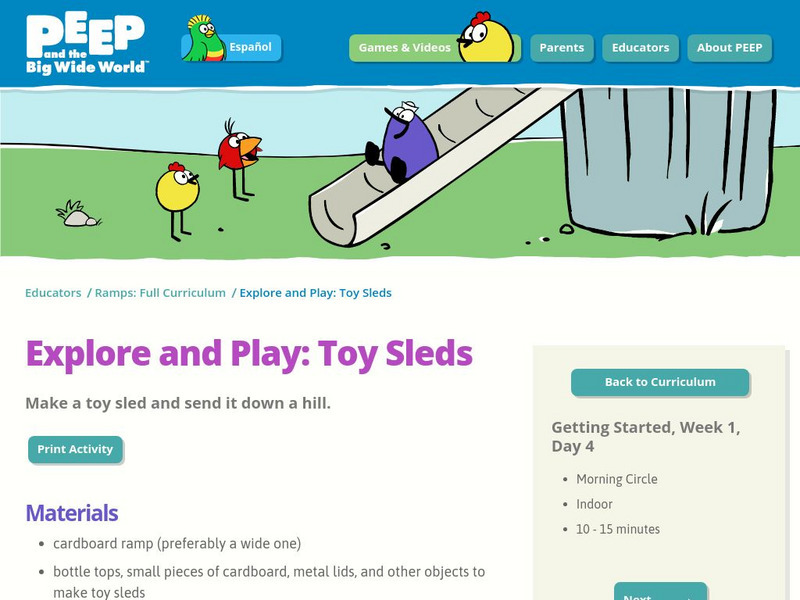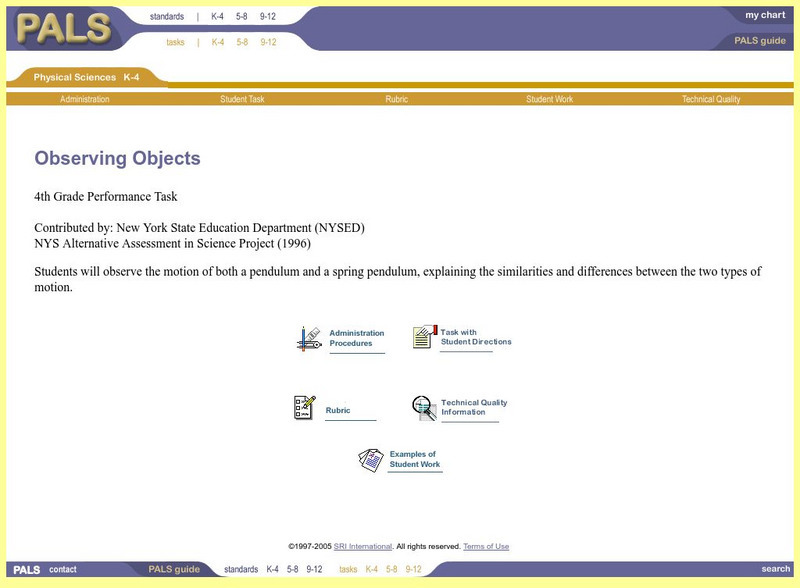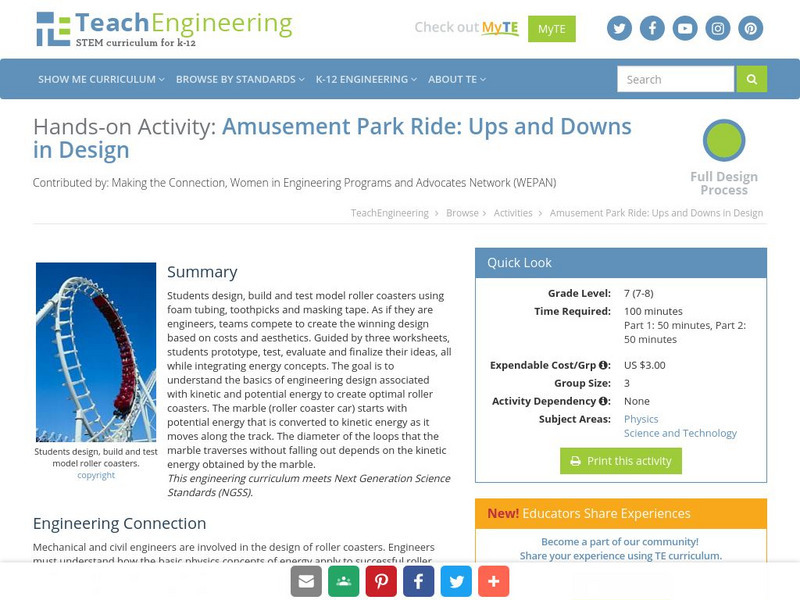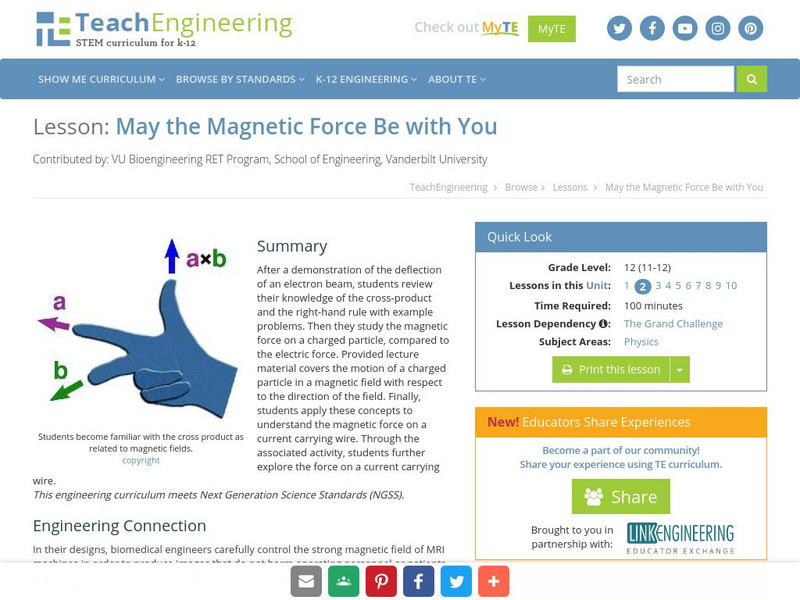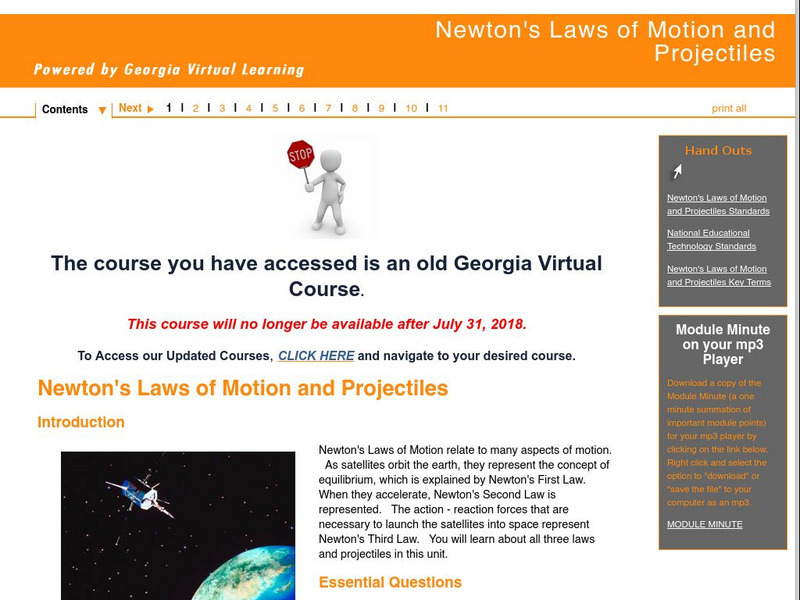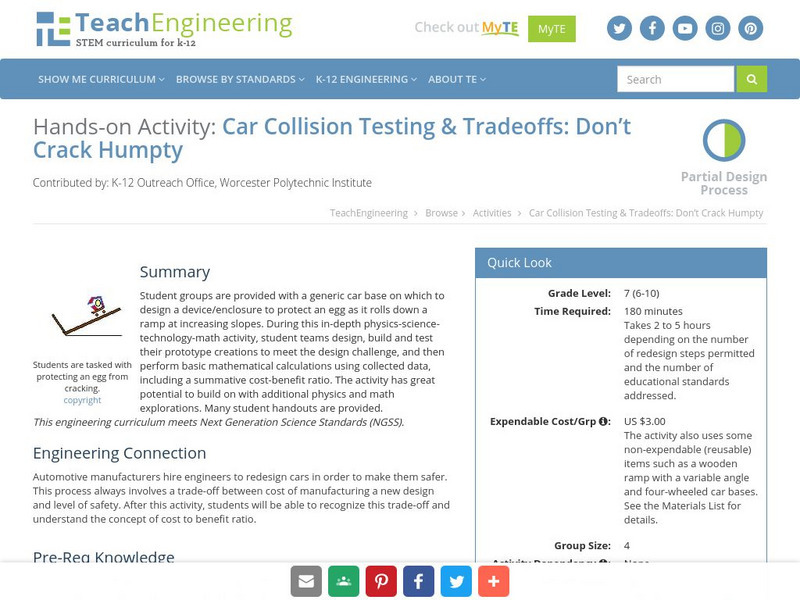TeachEngineering
Teach Engineering: Floating and Falling Flows
Students discover fluid dynamics related to buoyancy through experimentation and optional photography. Using one set of fluids, they make light fluids rise through denser fluids. Using another set, they make dense fluids sink through a...
PBS
Wgbh: Peep and the Big Wide World: Indoor Ramps
Have students make ramps out of flat pieces of cardboard and other materials.
Texas Instruments
Texas Instruments: Classroom Activities: Parachuting
This activity explores a parachutist and her position, velocity and acceleration. Graphing and calculating these functions will be required.
PBS
Wgbh: Peep and the Big Wide World: Roll or Slide?
A classroom activity where students discover whether an object rolls, slides, or stays put.
PBS
Wgbh: Peep and the Big Wide World: Ramps All Around
Take the learners outside on a walking field trip where they can notice ramps and slanted surfaces in the neighborhood.
PBS
Wgbh: Peep and the Big Wide World: Share the Day's Discoveries
Discuss classroom explorations and discoveries about ramps.
PBS
Wgbh: Peep and the Big Wide World: Explore and Play: Ramps Around Us
Set up several ramps around the room and allow the students to explore and investigate how they work.
PBS
Wgbh: Peep and the Big Wide World: Explore and Play: Sliding Peep
Students make their own ramps and test them out by sending various objects down them.
PBS
Wgbh: Peep and the Big Wide World: Read and Discuss: Ten on the Sled
Discussion and integrations ideas for the read aloud book, Ten on the Sled by Kim Norman.
PBS
Wgbh: Peep and the Big Wide World: Explore and Play: Snowy Hills
Students make two snowy hills, one steep and one gentle, to discover their effects on rolling objects.
PBS
Wgbh: Peep and the Big Wide World: Share the Day's Discoveries
Share and discuss ideas the students have about ramps and rolling objects.
PBS
Wgbh: Peep and the Big Wide World: Explore and Play: Toy Sleds
Students experiment with different materials and objects to make a sled that will slide down the ramps.
Utah Education Network
Uen: Rock a Bye Pendulum
Activity uses scientific process to explore the effects of force on an object in motion.
Massachusetts Institute of Technology
Mit: Open Course Ware: Forces: Moving Charges in Magnetic Fields
Learners investigate moving charges in magnetic fields. Some topics explored in the activities are Lorentz force, motion of a charge, and magnetic fields. The resource consists of video clips, lecture notes, online textbook chapters,...
TeachEngineering
Teach Engineering: Energy of Motion
By taking a look at the energy of motion all around us, students learn about the types of energy and their characteristics. They first learn about the two simplest forms of mechanical energy: kinetic and potential energy, as illustrated...
SRI International
Performance Assessment Links in Science: Observing Objects
This is a performance task for Grade Four students where they observe two different pendulums and compare the two types of motion. The activity is designed for a lab setting where students work at individual stations. A rubric and...
TeachEngineering
Teach Engineering: Amusement Park Ride: Ups and Downs in Design
This unit has students design and build foam tubing roller coasters. The design process integrates energy concepts as they test and evaluate their designs that address the task as an engineer would. The goal is for students to understand...
CK-12 Foundation
Ck 12: Plix Series: Newton's First and Second Laws
[Free Registration/Login Required] Read a force scenario, and then analyze the graphs provided to gain an understanding of inertia and force. After the activity, answer three challenge questions to check for understanding.
Khan Academy
Khan Academy: Activity: Frictional Force Experiment
A lesson about friction can be found on this website. Students will experiment to see how motion and frictional force affect the game of football.
Other
Bscs: Forces Lesson 1: What Makes Something Start to Move?
Through hands-on activities, this lesson will show students that a force is a push or a pull and forces cause changes in motion. Included are a minute-by-minute lesson plan, activities, and teacher discussion points and questions.
TeachEngineering
Teach Engineering: May the Magnetic Force Be With You
This lesson begins with a demonstration of the deflection of an electron beam. Students then review their knowledge of the cross product and the right hand rule with sample problems. After which, students study the magnetic force on a...
Georgia Department of Education
Ga Virtual Learning: Newton's Laws of Motion and Projectiles
Through informational text, interactive activities, practice problems, online labs, virtual simulations, and video clips, students learn about Newton's Laws of Motion.
TeachEngineering
Teach Engineering: Mechanics Mania
Through ten lessons and numerous activities, students explore the natural universal rules engineers and physicists use to understand how things move and stay still. Together, these rules are called "mechanics." The study of mechanics is...
TeachEngineering
Teach Engineering: Car Collision Testing & Tradeoffs: Don't Crack Humpty
Student groups are provided with a generic car base on which to design a device/enclosure to protect an egg as it rolls down a ramp at increasing slopes. During this activity, student teams design, build and test their prototype...

